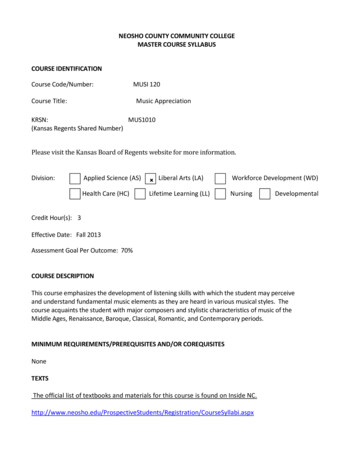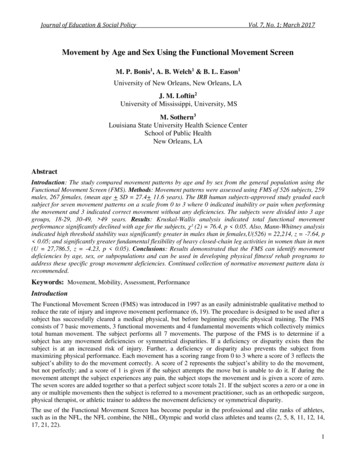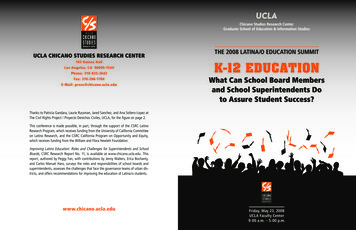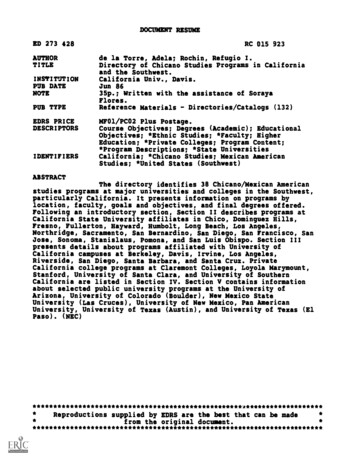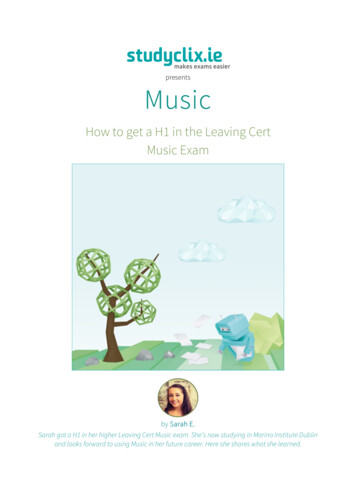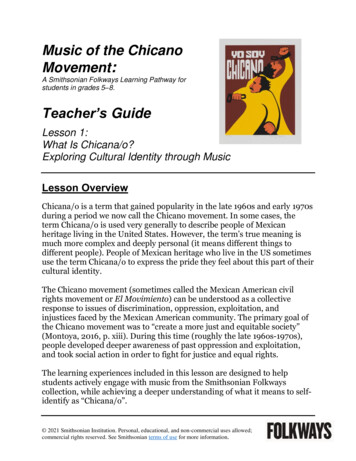
Transcription
Music of the ChicanoMovement:A Smithsonian Folkways Learning Pathway forstudents in grades 5–8.Teacher’s GuideLesson 1:What Is Chicana/o?Exploring Cultural Identity through MusicLesson OverviewChicana/o is a term that gained popularity in the late 1960s and early 1970sduring a period we now call the Chicano movement. In some cases, theterm Chicana/o is used very generally to describe people of Mexicanheritage living in the United States. However, the term’s true meaning ismuch more complex and deeply personal (it means different things todifferent people). People of Mexican heritage who live in the US sometimesuse the term Chicana/o to express the pride they feel about this part of theircultural identity.The Chicano movement (sometimes called the Mexican American civilrights movement or El Movimiento) can be understood as a collectiveresponse to issues of discrimination, oppression, exploitation, andinjustices faced by the Mexican American community. The primary goal ofthe Chicano movement was to “create a more just and equitable society”(Montoya, 2016, p. xiii). During this time (roughly the late 196os-1970s),people developed deeper awareness of past oppression and exploitation,and took social action in order to fight for justice and equal rights.The learning experiences included in this lesson are designed to helpstudents actively engage with music from the Smithsonian Folkwayscollection, while achieving a deeper understanding of what it means to selfidentify as “Chicana/o”. 2021 Smithsonian Institution. Personal, educational, and non-commercial uses allowed;commercial rights reserved. See Smithsonian terms of use for more information.
2In this GuideLesson Overview . 1Lesson Components and Student Objectives . 2Teaching Plan . 32014 National Music Standards Connections . 8Additional Reading and Resources . 9Worksheets . 10Lesson Components and Student Objectives*1. What Is Chicana/o? (approx. 30 minutes) Students will identify textual and musical clues about Chicana/oidentity.Students will identify the typical instrumentation ofmúsica norteña.2. What Was the Chicano Movement? (20-25 minutes) Students will describe several rationales for the Chicano movement.3. Exploring Cultural Identity through Music (45 minutes) Students will explain why certain songs became anthems to peoplewho identified as Chicana/o during the Chicano movement. Students will explain how music can celebrate/re-affirm culturalidentity and serve as a symbol of cultural pride. Students will use music to describe important aspects of their owncultural identity.*Note: The learning icons used above signify the type of learning used in eachComponent. Keep in mind that these Components are not intended to be sequential;rather, teachers or students may choose which Components they’d like to use from eachLesson.While all learning types (History and Culture, Music Listening,Music Makingand Creation, andCreative Connections) fulfill 2014 National Music Standards, nonmusic teachers will be able to useHistory and Culture andCreative ConnectionsComponents without specific musical knowledge.
3Teaching Plan1. Component One: What Is Chicana/o?To prepare: Preview Component 1 of the Lesson 1 Slideshow.Print the “Chicano” song lyrics for each student (find below).Process: Guide student learning while facilitating the student slideshow Open the “Launch Slideshow” link on the righthand menu of the Lesson landingpage. If you are able to use a different screen than the students, have them open the“Student Slideshow” link, which will not show the notes.1. Discussion: What is Chicana/o? Ask students what they think the word Chicano means before starting the lessonin order to assess prior knowledge on the topic. Address the discussion points that are embedded in the slideshow.2. Attentive Listening Activity: “Chicano”Listen to the recording of “Chicano” by Rumel Fuentes and Los Pingüinos del Norte. While listening, students should fill in missing words on the lyrics document(which provide clues about Chicana/o identity). Consider leading a short class discussion based on student responses(discussion points are embedded in the slideshow).3. Attentive Listening Activity: “Chicano”What do the musical sounds communicate about Chicana/o identity? Listen to several short excerpts from this recording (about 30–45 seconds at atime) and ask the following questions after each excerpt: Where (geographically) would you be most likely to hear this music?o Música norteña (MOO-see-kah nor-TEHN-ya) is a musical genrethat originated in northern Mexico.o It is one of many regional traditions heard in south Texas andalong the US/Mexican border (both sides . . . conjunto is the termusually used on the Texas side of the border). What instruments do you hear?o Accordion, steel-string guitar, 12-steel-string guitar, tololoche(contrabass)
44. Connections: Who are the musicians?o Rumel Fuentes and Los Pingüinos del Norteo Contextual information is provided within the slideshow. Show the short video clip of Rumel Fuentes/ Los Pingüinos del Norte playing thissong.5. Attentive Listening Activity: “Chicano”Listen to another short excerpt while thinking about this question: What do you notice about the language?o Throughout the song, English and Spanish are intertwined (this issometimes called “Spanglish”).6. Discussion:Why do you think some people in the Mexican American community have (andcontinue to) identify as Chicana/o? Important points are highlighted within the slideshow.
52. Component Two: What Was the Chicano Movement?To prepare: Preview Component 2 of the Lesson 1 Slideshow. Print the “Yo soy tu hermano, yo soy Chicano” song lyrics for each student (findbelow).Process: Guide student learning while facilitating the student slideshow. Open the “Launch Slideshow” link on the righthand menu of the Lesson landingpage. If you are able to use a different screen than the students, have them open the“Student Slideshow” link, which will not show the notes. Scroll to the Component Menu slide (slide 3) and click on Component 2.1. Discussion:What were the primary goals of the Chicano movement? Unpack the discussion points provided on the slides.2. Attentive Listening Activity: “Yo soy tu hermano, yo soy Chicano” Listen to “Yo soy tu hermano, yo soy Chicano” by Conjunto Aztlan. Ask students to underline or circle words that provide clues about why people inMexican American communities felt like an ‘uprising’ was needed during the timeof the Chicano movement.3. Discussion: “Yo soy tu hermano, yo soy Chicano”Lead a short class discussion based on student responses to the listening exercise. Discussion points are embedded in the slideshow.4. Optional Extension Activity: Issues and ImagesIn this optional activity, students will find and print historical images that illustrateseveral specific goals of the Chicano movement: rights for farm workers,restoration of land, and education reform. After students collect the images, the teacher can create a class collage using theprints. Alternately, this could become a group or individual creative writing activity thatcomes out of deeper consideration of the images. Either students can develop askit based on characters from the images, or individual students can write aboutthe views of the person in a short statement. Encourage students to consider theirsituation from the first-person perspective. This will encourage students toempathize with the individuals and their goals and reasons for joining the
6 movement. In a group activity, students could create a short conversation or skitbased around the historical events they learned about in the lesson. Alternately,they could make an individual statement in the first person, a kid of characterportrayal of a person in one of the photos. Encourage them to interpret the photoby thinking about the context and Chicano movement goal (farm worker rights,land restoration, or education reform).NOTE: Farm worker rights are covered more deeply in Lesson 6,education reform in Lessons 7 and 12, and land restoration in Lessons3 and 8.
73. Component Three: Exploring Cultural Identitythrough MusicTo prepare: Preview Component 3 of the Lesson 1 Slideshow.Print the “Yo soy Chicano” song lyrics for each student (find below).Print the “My Multicultural Self” worksheet1 for each student (find below).Print the “Exploring Cultural Identity through Music” worksheet for each student(find below).Process: Guide student learning while facilitating the student slideshow. Open the “Launch Slideshow” link on the righthand menu of the Lesson landingpage. If you are able to use a different screen than the students, have them open the“Student Slideshow” link, which will not show the notes. Scroll to the Component Menu slide (slide 3) and click on Component 3.1. Discussion: What is an anthem? Unpack the discussion points provided on the slides.2. Attentive Listening Activity: “Yo soy Chicano” While listening, students will circle or underline words as they identify song lyricsthat celebrate/re-affirm Chicana/o cultural identity.3. Discussion: “Yo soy Chicano” Lead a short class discussion based on student responses to the listening exercise.4. Discussion:Cultural identity is complicated! Unpack the discussion points provided on the slides.5. Creative Activity 1: My Multicultural SelfStudents will identify important aspects of your cultural identity. Explicit instructions are provided in the slideshow and on the worksheet. NOTE: This can be completed during class or as homework.6. Creative Activity 2: Music and Cultural IdentityStudents will choose an anthem that reflects one aspect of their cultural identity andwill explain their choice. NOTE: This can be completed during class or as homework. A rubric for this activity is provided below.1Reprinted with permission of Teaching Tolerance, a project of the Southern Poverty LawCenter www.tolerance.org.
82014 National Music Standards ConnectionsMU:Re7.1.a Select or choose music to listen to and explain the connections to specificinterests or experiences for a specific purpose. Can I select an anthem that reflects one facet of my cultural identity?MU:Re7.2.a Describe how the elements of music and expressive qualities relate to thestructure of the pieces. Can I describe how the musical elements used in the recording of the song“Chicano”?MU:Re7.2.b Identify the context of music from a variety of genres, cultures, and historicalperiods. Can I explain the context of these musical recordings?MU:Re8.1.a Describe a personal interpretation of how creators’ and performers’ applicationof the elements of music and expressive qualities, within genres and cultural and historicalcontext, convey expressive intent. Can I interpret how the musicians featured on these musical recordings convey whatit means to identify as Chicano?MU:Cn10.0.a Demonstrate how interests, knowledge, and skills relate to personal choices andintent when creating, performing, and responding to music. Can I explain why the anthem I chose reflects my cultural identity?MU:Cn11.0.a Demonstrate understanding of relationships between music and the other arts,other disciplines, varied contexts, and daily life. Can I explain how the songs in this lesson were used during the Chicano movement? Can I describe how music functions as an expression of cultural identity and a symbolor cultural pride?
9Additional Reading and ResourcesAzcona, E. C., & Rodriguez, R. (2005). Rolas de Aztlán: Songs of the Chicano movement[Liner notes]. Smithsonian Folkways Recordings. https://folkwaysmedia.si.edu/liner notes/smithsonian folkways/SFW40516.pdfBlank, L., & Strachwitz, C. (1976). (Directors). Chulas fronteras [Film]. Les Blankfilms. /Escobar, E. J. (1993). The dialectics of repression: The Los Angeles police departmentand the Chicano movement, 1968-1971. The Journal of American History, 79(4),1483–1514. https://www.jstor.org/stable/2080213Gonzalez, J. (2015, October 15). The big list of discussion strategies. Cult of istening-techniques/Montoya, M. (2016). The Chicano movement for beginners. For Beginner Books.Reading and Writing Haven (n.d.). 12 powerful discussion strategies to engagestudents. Reading and Writing Haven: A Blog for /Rosales, F. A. (1996). Chicano! The history of the Mexican American civil rightsmovement. Arte Público Press.Strachwitz, C. (1995). Chulas fronteras [Liner notes]. Arhoolie Records.https://folkways-media.si.edu/liner notes/arhoolie/ARH00425.pdfZettler, J. (2009). Corridos of the Chicano movement [Liner notes]. Arhoolie Records.https://folkways-media.si.edu/liner notes/arhoolie/ARH00507.pdf
10Worksheets“Chicano” song lyricsby Doug Sahm; Recorded by Rumel Fuentes and Los Pingüinos del NorteWhile you listen to this song, fill in the blanks with words that provide clues aboutChicana/o identity.Chicano, soy Chicano‘Cause I’m and I’mAnd I’ll make it in my own way.Some people call meBut I know that is the real world‘Cause to me all I am is Mexicano.Translation:Chicano, I’m Chicano‘Cause I’m and I’mAnd I’ll make it in my own way.Some people call meBut I know that is the real world‘Cause to me all I am is Mexican.Chicano, soy ChicanoAll my brothers right now.And all across the USAI just woke up and sayChicano, soy ChicanoRight On!Chicano, I’m Chicano,All my brothers right now.And all across the USAI just woke up and sayChicano, I’m ChicanoRight On!Chicano, soy ChicanoI can fly just as high andAs long as I want to.Some people call me‘Cause I’m no longer thePobrecito Mexicano.Chicano, I’m ChicanoI can fly just as high andAs long as I want to.Some people call me‘Cause I’m no longer theDisempowered Mexican.Keep filling in the blanks with words that relate to Chicana/o identity.Chicano, soy ChicanoMis hermanos organicen pero yáTodo el mundo lo sabráY este vato les diráChicano, soy Chicano¡Dale shine!Chicano, I’m ChicanoAll my brothers right nowAnd all across the USAI just woke up and sayChicano, I’m ChicanoRight On!Chicano, soy Chicano‘Cause I’m and I’mAnd I’ll make it in my own way.Some people call me‘Cause I’m no longer thePobrecito Mexicano.Chicano, I’m Chicano‘Cause I’m and I’mAnd I’ll make it in my own way.Some people call me‘Cause I’m no longer theDisempowered Mexican.Chicano, soy ChicanoSoy café, tengo orgulloY yo se que yo la voy a hacer.Unos me dicen, “hippy”Otros me dicen, caifán,Pero yo solo se que soy puro Mexican!¡Pa’ que sepan!Chicano, I’m Chicano‘Cause I’m and I’mAnd I’ll make it in my own way.Some people call me hippyOthers call me a bumBut all I am is pure Mexican.Now you know!
11“Yo soy tu hermano, yo soy Chicano” song lyricsRecorded by: Conjunto AztlanWhen you listen to this song, underline or circle words that provide more clues aboutwhy people in Mexican American communities felt like an ‘uprising’ was neededduring the time of the Chicano movement.Dicen que ando alborotandoPorque con mi raza quiero despertar.Tanta injusticia me está rodeandoYa no me aguanto, yo quiero pelear.They say I am stirring things upBecause I want to wake up my peopleSo much injustice is all around me,I cannot stand it any longer, I want to fight.(Estribillo)Yo soy tu hermano, yo soy Chicano.Dame tu mano, vamos a volar.Bien dice el dicho: si sangra mi hermano,Yo también sangro, la herida es igual.(Refrain)I am your brother, I am Chicano.Give me your hand, let’s fly.As the saying goes: If my brother bleeds,I also bleed, the wound is the same.Roban las tierras, roban trabajos,Mataron a mi hermano allá en Vietnam.Perdón le pido a la Guadalupana:Tanta injusticia, me hicieron pelear.They steal lands, they steal jobs,They killed my brother over there in Vietnam.I ask forgiveness of the Virgen of GuadalupeSo much injustice, they made me fight.(Estribillo)(Refrain)Como Zapata y Pancho Villa,A los tiranos quiero castigar.Hambre y pobreza me están matando,Yo no me aguanto, yo quiero pelear.Like Zapata and Pancho Villa,I want to punish the tyrants.Hunger and poverty are killing me,I cannot stand it; I want to fight.Keep circling or underlining words that relate to the need for uprising, but see if youcan also find the words in Spanish.(Estribillo)(Refrain)Yo soy tu hermana, yo soy Chicana.Dame tu mano, vamos a volar.Bien dice el dicho: si sangra mi hermana,Yo también sangro, la herida es igual.I am your sister, I am Chicana.Give me your hand, let’s fly.As the saying goes: if my sister bleeds,I also bleed, the wound is the same.Ya estoy cansado de voltear la cara,Ya mi paciencia ya se me acabó.Chotas y rinches son muy desgraciados,Y la ley gringa se burla de mí.I am tired of turning my cheek,My patience has just run out.Cops and Rangers are disgraceful,And gringo law mocks me(Estribillo)(Refrain)Yo soy tu hermana, yo soy Chicana.Dame tu mano, vamos a volar.Bien dice el dicho: si sangra mi hermana,Yo también sangro, la herida es igual.¡Yo soy Chicano!I am your sister, I am Chicana.Give me your hand, let’s fly.As the saying goes: When my sister bleeds,I also bleed, the wound is the same.I am Chicano!
12“Yo soy Chicano” song lyricsRecorded by: Los AlvaradosWhile you listen to this song, circle or underline words that celebrate Chicana/ocultural identity.(Estribillo)Yo soy Chicano, tengo color,Puro Chicano, hermano con honor.Cuando me dicen que hay revolución,Defiendo a mi raza con mucho valor.(Refrain)I am Chicano, of color,Pure Chicano, a brother with honor.When they tell me there is revolution,I defend my people with great valor.Tengo todita mi gentePara la revolución.Voy a luchar con los pobresPa’ que se acabe el bolón.I have all my peopleFor the revolution.I am going to fight alongside the poorTo end this oppression.(Estribillo)(Refrain)Tengo mi par de pistolasPara la revolución.Una es una treinta y treinta,Y otra es una treinta y dos.I have my pair of pistolsFor the revolution.One is a thirty-thirty,And the other is a thirty-two.Keep circling or underlining words that celebrate Chicana/o identity, but see if you canalso find the words in Spanish.(Estribillo)(Refrain)Tengo mi par de caballosPara la revolución.Uno se llama “El Canario,”Y otro se llama “El Gorrión.”I have my pair of horsesFor the revolution.One is called “El Canario” (The Canary)The other is called “El Gorrión” (The Sparrow).(Estribillo)(Refrain)Tengo mi orgullo y machismo,Mi cultura y corazón.Tengo mi fe y diferencia,Y lucho con gran razón.I have my pride and my manliness,My culture and my heart.I have my faith and differencesAnd I fight with great conviction.(Estribillo)(Refrain)Tengo todita mi gentePara la revolución.Voy a luchar con los pobresPa’ que se acabe el bolón.I have all my peopleFor the revolution.I am going to fight alongside the poorTo end this oppression.Tengo mi orgullo, tengo mi fe.Soy diferente, soy color café.Tengo cultura, tengo corazón,Y no me lo quita a mí ningún cabrón.I have my pride, I have my faith.I am different, I am of brown color.I have culture, I have heart,And no son-of-a-gun will take it away from me.
13
14Exploring Cultural Identity through Music WorksheetName:1. Which “identity bubble” did you choose to focus on for this part of the activity?2. Which song did you choose as your anthem for this facet of your identity?3. Write out the lyrics to the song you chose in the space provided below:4. Can you find a place (or places) in the lyrics that “celebrates” this facet of your identity?(Underline it)5. Can you find a statement (or statements) in the lyrics that is “inspiring”, “motivating”, or“uplifting”? (Circle it)6. Write 2-3 sentences that describe why this song serves as a symbol of pride (an anthem)for this facet of your cultural identity.
15
16Exploring Cultural Identity through Music AssignmentRubric2014 National Music Standards Documentation for this Learning Experience (5th-8th Grade):MU:Re7.1.a Select or choose music to listen to and explain the connections to specific interests orexperiences for a specific purpose. Select an “anthem” that reflects one aspect of your cultural identity.MU:Cn10.0.a Demonstrate how interests, knowledge, and skills relate to personal choices and intentwhen creating, performing, and responding to music. Explain why this song reflects your cultural identity and serves as a symbol of cultural pride.Suggested Rubric for Standards Documentation:4 ExceedsStandard3 Meets Standard2 ApproachingStandard1 Does Not MeetStandardThe song selected bythe student clearlyconnected to the facetof identity they weretrying to reflect.The song selected bythe student connectedto the facet of identitythey were trying toreflect.With assistance, thestudent selected a songthat connected to thefacet of identity theywere trying to reflect.The song selected bythe student did notconnect to the facet ofidentity they weretrying to reflect.The student identifiedseveral places in thelyrics that “celebrated”this facet of theiridentity.The student identifiedone place in the lyricsthat “celebrated” thisfacet of their identity.With assistance, thestudent identified aplace in the lyrics that“celebrated” this facetof their identity.The student did notidentify a place in thelyrics that “celebrated”this facet of theiridentity.The student identifiedseveral places in thelyrics that were“uplifting”, “inspiring”,or “motivating.”The student identifiedone place in the lyricsthat was “uplifting”,“inspiring”, or“motivating.”With assistance, thestudent identified aplace in the lyrics thatwas “uplifting”,“inspiring”, or“motivating.”The student did notidentify a place in thelyrics that was“uplifting”, “inspiring”,or “motivating.”The student’s responseartistically andimaginatively includedspecific reference tointerests, values, priorknowledge and/orexperiences.The student’s responseincluded specificreference to interests,values, priorknowledge and/orexperiences.The student’s responseincluded general butnot specific reference tointerests, values, priorknowledge and/orexperiences.The student’s responsedid not includereferences to interests,values, priorknowledge and/orexperiences.
Lead a short class discussion based on student responses to the listening exercise. Discussion points are embedded in the slideshow. 4. Optional Extension Activity: Issues and Images In this optional activity, students will find and print historical images that illustrate several specific goals of the Chicano movement: rights for farm workers,



